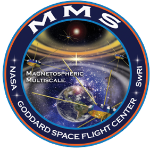The foreshock is the region upstream of the quasi-parallel Earth's bow. Within it a variety of backstreaming ion populations exist, which are able to generate ion-ion instabilities leading to ultra-low frequency (ULF) waves. Among them are the 3 sec waves discovered by Le et al. (1992). These waves as their name indicates, have 3 second periods and are observed in the plasma when the plasma beta is high. They are always right-hand nearly circularly polarized in the spacecraft frame and are convected downstream by the solar wind. Three second waves can exist in different regions of the foreshock where other waves can also exist. Blanco-Cano et al (1999) showed that when 3 second waves are in regions with a quiet magnetic field, they are accompanied by cold reflected ion beams. These authors also showed that sometime 3 second waves are superposed to 30 second fluctuations. In this work we use Magnetospheric Multiscale (MMS) Mission magnetic field and plasma data to study in more detail 3 sec waves properties and their association with different ULF waves and ion populations. We will also use data from the past MMS string of pearl configuration for a more accurate characterization of the waves. Dispersion solver analysis will also be performed to determine the origin of 3 second waves and accompanying modes.
|
|
|
Submissions (by speaker) > Blanco Cano XochitlOrigin of three second foreshock waves observed by the MMS mission.
1 : Universidad Nacional Autónoma de México
2 : Catholic University of America/NASA GSFC
3 : NASA/GSFC
4 : Catholic University of America
5 : University of California, Los Angeles
6 : University of Michigan [Ann Arbor]
|

 PDF version
PDF version
